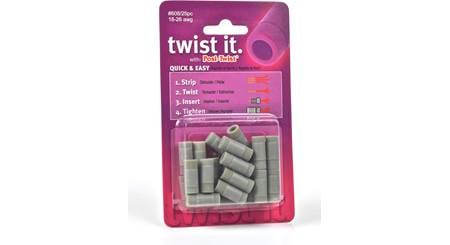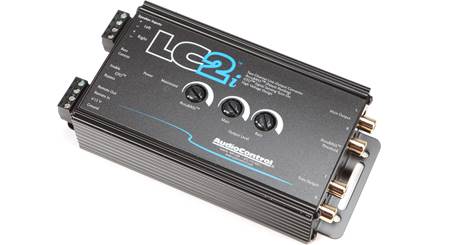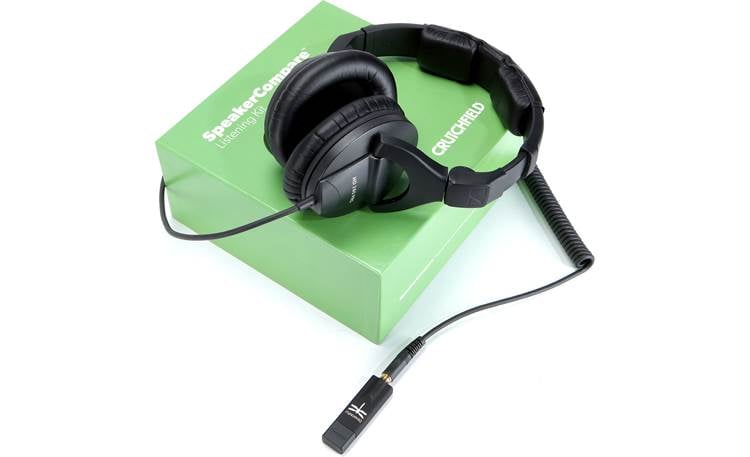2016 Kia Sportage gets amped
Adding an amplifier to a digital factory audio system

In this article, we'll take an in-depth look one way to add an amplifier to a factory audio system. We had to deal with something that's become a common problem in newer vehicles – digital audio signal going to the factory amp and multichannel outputs coming out of it.
P
icture this: You've taken the plunge on a new car, and even ponied up for the deluxe infotainment package. You like the tech it offers — the nav, the Bluetooth®, the smartphone integration, and voice control, but the sound quality leaves you feeling as flat as...well, as flat as the sound itself.
If this has happened to you, don't worry. This is a fixable problem that doesn't require replacing that factory stereo or any of the features you like so much. All it takes is a key upgrade or two. To demonstrate what we mean, we installed a new amplifer, subwoofer, and speakers in a 2016 Kia Sportage with a premium factory system.

I'm explaining some of the amp controls to Steph.
Poor audio quality – a common complaint about newer cars
The Kia in question belongs to Steph, an elementary school teacher. Her dad's a longtime colleague of ours, so she's grown up with plenty of exposure to the car audio industry. That's how she knew that the Kia's sound quality just wasn't going to cut it, no matter how much she liked everything else the A/V system had to offer. We were happy to help, and by helping her, help our customers get a sense of what's possible in their vehicles.
Better sound needs amplified power
Broadly speaking, adding a 4-channel amplifier to drive new speakers can make a huge difference when you're trying to coax better sound out of a factory radio. Even if you have an external factory amplifier, like Steph's Kia, an aftermarket amp will dramatically increase the power. This is a great thing, because extra power produces more detail and helps overcome the negative effects of wind, traffic, and road noise.
To get the sound from your factory stereo to a new amplifier, you almost always need to tap into the factory speaker wires and connect them to the amp's speaker-level inputs (just make sure you get an amp that has these inputs). This presents a much higher-voltage signal to the amp than the typical aftermarket method of preamp outputs and inputs. The amp then steps the voltage down a bit before proceeding to amplify things.
Digital signals and extra speakers – obstacles for a new amplifier
Steph's Kia presented a fairly big challenge that's become common to many modern vehicles: the factory stereo sends a purely digital signal to the amplifier, where it's processed, amplified, and sent on to the factory component speakers. That meant that we had to tap into the speaker wires after the factory amplifier, because speaker-level signals going to a new amplifier need to be analog. So we were going to be presenting a pretty high-voltage signal to the new amp.

The Kia's factory amp, which is tucked behind a panel in the cargo area.
On top of that, the factory amp in her Kia has separate outputs for the woofers and tweeters of the factory component system, with only high frequencies going to the tweeters, and lower frequencies going to the woofers. Most 4-channel amps with speaker-level inputs only offer one set of each for front and rear channels. This posed the potential problem of leaving out an entire range of frequencies.
So, to summarize:
- We couldn’t use the signal coming into the factory amp because it’s digital and we need analog.
- The output side is split into highs and lows coming straight out of the amp, and most aftermarket amplifiers can’t deal with that.

The AudioControl LC-4.800 amplifier offers some key features that make it a great option for adding to a factory stereo.
Finding the right amplifier for the job
The AudioControl LC-4.800 provided the ideal solution to both of these issues. First off, its speaker-level inputs will handle up to 400 watts, which is huge. Handling the amplifier signal from the Kia's amp would be no problem.
But even more importantly, the LC-4.800 offers separate high- and midrange speaker-level inputs for the front channels, specifically to accommodate premium systems like these. When both of these inputs are in use, the amp combines the ranges of the two inputs and sends out one full-range signal that doesn't leave anything out. That's the big reason we chose this amplifier — there aren't many other aftermarket amps that can do this.
Generally speaking, any amplifier with a built-in DSP (digital signal processor) could work in this situation. If your amplifier doesn't have DSP capabilities, then you can add a line output converter to your system. It'll do the signal routing and processing and deliver the proper signal to your amplifier.
[See all of our amplifiers with a built-in DSP]
Read more about adding an amplifier to an amplified factory system in these articles:
- Adding an amplifier to an amplified factory system
- How to know if speaker-level inputs alone will work

High- and midrange speaker-level inputs on the AudioControl amp accommodate factory systems with separate tweeter and woofer output wires.
Making the input and output connections
Here's what I did. With the help of our tech support department, I identified which wires coming out of the factory amp went to which speakers (this sort of help is available to all of our customers, incidentally). Then, I got a little creative.
I knew that the same set of wires from the car’s amp were going to be used for the AudioControl amp’s inputs and outputs. Basically, I was going to have to cut each wire, connect new wires to each end, and run these two sets of new wires to the AudioControl amplifier:
- The connection from the factory amplifier would go to the appropriate speaker-level input on the AudioControl amp.
- The other connection would go to the appropriate AudioControl output, and send signal to the speakers.
The right speaker wire for the job
when doing installations like these, 9-wire speaker cable is a lifesaver. The wire colors match the standards for aftermarket speaker outputs: white for front left, gray for front right, green for rear left, and purple for rear right. I used this same color strategy for the each of the front and rear inputs.
For the dedicated factory tweeter wires, I used lengths of wire with colors that weren't in the 9-wire bundle (and wrote down the color codes on the same sheet of paper that listed the factory wire colors). That helped keep me from getting confused when working with all of these different strands.
After clipping each factory speaker wire, I connected each new wire using a Posi-Products connector. That made for a clean, easy, connection without having to deal with a soldering iron and solder in the cargo area. With all the input wires connected, next I plugged each of them into the AudioControl's speaker-level input harness, then plugged the harness into the amp.

Posi-Products connectors made a nice, neat job of splicing into the factory speaker wires for the amplifier input signal.
For the speaker outputs, I used another length of the 9-wire cable, connecting one end of each of the wires to the speaker outputs of the amp, then the other end to the factory wires, again using Posi connectors, and again following the standard aftermarket wire-color scheme. Because I only needed four sets of connections this time, each offering the full range of frequencies, I taped off the ends of the factory tweeter output wires going to the speakers, since they'd no longer be used.
High-end speakers to handle the new power
Since Steph didn't want to mess around with inferior sound, the choice of replacement speakers was obvious to her: AudioFrog. Generally speaking, these boutique speakers offer rich detail, and warm, inviting tone. They'll also handle a whole lot of power, making them great matches for the 125-watt RMS LC-4.800 amplifier.
As I mentioned above, Steph's Kia came with factory component speakers. However, AudioFrog tweeters are a bit too big for the factory tweeter locations in the sail panels, and Steph wasn't too keen on modifiying her still-new door panels (which was totally understandable). So we opted for the GS62 coaxials, which we knew would fit in her doors neatly.

These AudioFrog coaxials were a perfect fit in the doors of the Sportage.
To my surprise (though maybe I shouldn't have been), the soundstaging with these speakers was astonishing. Despite being mounted somewhat low in the doors, it sounded to my ears that the stage was nice and high, as though the band were playing right on the dash, exactly where you'd want it to be. That's a strong testament to the admirable quality AudioFrog brings to the mobile A/V arena. Without doing much tuning, I could hear a tremendous amount more detail, and the volume ceiling was much, much higher.
Improving the Kia's bass performance
Steph's Kia came with a factory subwoofer mounted behind the right-side panel in the cargo area, but it just wasn't giving her the bass she really wanted. AudioFrog and AudioControl to the rescue again.
To give her new sub full, dedicated power, we added an AudioControl mono amplifier into the mix. It's often the case that factory stereos limit the bass level as you raise the volume to keep from damaging the cheap factory speakers found in most cars. AudioControl's bass restoration keeps that from happening when you use it with aftermarket equipment.

Choosing wires that matched the factory subwoofer wire colors helped keep things nice and organized. I tapped into the wires right at the factory sub's input harness.
To get signal to the mono amp, I used Posi-Products taps to splice into the factory sub's input wires, which once again, I identified with the help of our tech department. I used wires that matched the factory colors to keep things clear and easy, and plugged them right into the amp's speaker-level input harness.
Next, it was time to connect the amp to the 12" AudioFrog subwoofer. I fired up the system and...holy moly. The sub began pounding, even with the amp's gain set all the way down. It hit hard, played loud, and after setting the low-pass crossovers to about 75 Hz, played with satisfyingly musical accuracy. Oh, it was good.
A note on amplifier installation
As far as power goes, when you're connecting an amp to a factory stereo, you'll still need to run power wire to the vehicle's battery, and a ground wire to the vehicle's chassis. In Steph's Kia, I ran 1/0-gauge cable from the battery and passed it through the firewall by cutting a hole in a gasket that was already allowing factory wiring to enter the vehicle's cab (I sealed the hole around the power wire with silicone to make sure no water can get in). For the ground, I used a seat belt bolt in the back seat, making sure to scrape away enough paint to allow the terminal ring to touch bare metal.
With both the power and ground wires, I used distribution blocks. The 1/0-gauge wires from the battery and ground locations went in one side, and out the other side ran the 4-gauge wires that connect to the amplifiers. Distribution blocks are incredibly helpful when you're dealing with a multi-amp installation because they allow you to make just one power and one ground connection to the car.
If you'd like more information about what goes into wiring and mounting amps, be sure to check out our amp installation guide, which neatly covers the basics.

What about your car?
If you're ready to ditch the factory sound while keeping your factory stereo, be sure to contact one of our highly trained advisors to make sure you get everything you need. All Crutchfield purchases come with free lifetime tech support, which means installation guidance and advice is just a phone call away.









David
Posted on 10/7/2023
How can I make sure my car stereo speaker output is digital or analog? I have a Mini F56 with no h/k or asd (so no amplifier I think) will speaker level input work properly? Also, I can tap to the speakers cable wherever I want? (Both to the cable going out from my stereo and both to the cable going into my speaker?) Thanks.
Buck Pomerantz from Crutchfield
on 10/9/2023
Ken
Posted on 9/2/2023
Where or how did you figure out what wires coming out of the factory were for what speakers? I have a 22 Kia Forte GT with Harmon Kardon system. I already have an LC2i with aftermarket sub and Amp, but I just tapped the wires on the sub for inputs to LC2i. Need to figure out which wires have full range signal.
Buck Pomerantz from Crutchfield
on 9/5/2023
Brad Robinson from Minneola
Posted on 6/4/2023
Thank you so much for doing an article for KIA Sportage owners!!! It seems as if no one wants to touch these cars, especially when the owner wants to keep the factory radio. Thanks again!!! Keep up the great work!!!
Anthony LaGrasta from Mission Viejo
Posted on 1/29/2019
2018 Kia Niro - I cannot locate anywhere online, a wire harness diagram. The model above mine has a factory sub in the back and although my model doesn't, I suspect the wire is still there. I want to use it to signal my aftermarket mono amp and sub. Thoughts, Suggestions, Advice?
Buck Pomerantz from Crutchfield
on 2/2/2019
Peppe from Siracusa (Italy)
Posted on 10/4/2018
Hi, I have a different problem guys! It seems that the factory navi audio system amplifier doesn't work! So I need to bypass it. The factory car radio output is a SPDIF signal. No high level or RCA or line signal from the radio...only SPDIF. Now I wonder which components I have to consider (amplifier, processor, dsp...) to keep the factory car radio also all controls (steerin wheels controls, backup camera, audio from navi...etc.). Excuse me for my bad english. Thanks
Buck Pomerantz from Crutchfield
on 10/5/2018
Grant from Stl
Posted on 12/30/2017
Jerker I've been searching for an adapter. You state you order it from your Kia dealer? I'd really like some more information and a picture, to show the Kia parts department. Thanks!!
Jerker from Uppsala (Sweden)
Posted on 5/19/2017
I managed to by this amplifier bypass harness directly from my Kia reseller today. The part number (here in Sweden) are 1898000106AS. Better to use that one instead of cutting of cables. [Link to harness photo removed]
Buck Pomerantz from Crutchfield
Posted on 5/9/2017
Jerker, The wiring schemes are different between vehicles marketed in different countries. I'm afraid you'll have to continue searching through online Kia forums for that information. Maybe a local car audio dealership can help.
Jerker from Uppsala (Sweden)
Posted on 5/6/2017
Hi! Great information about how to upgrade the soundsystem. I have exactly the same car and audiosystem and I´m also about to upgrade everything. I would be really happy if you could helping me with the correct wiring information. I cant find any good information about colors of all the cables at Internet so if you can post the information here I would be happy.
Ralph Bell from Star Ms
Posted on 4/1/2017
Man oh man! I was in the car stereo bus. Way back in the early days 80s and 90s and had some pretty ban systems back in the day, and have made purchases from Crutchfield. Well now have just got a new Honda HRV with nag love it but can stand to improve the sound so this article has got me motivated can't wait! Thanks Crutchfield